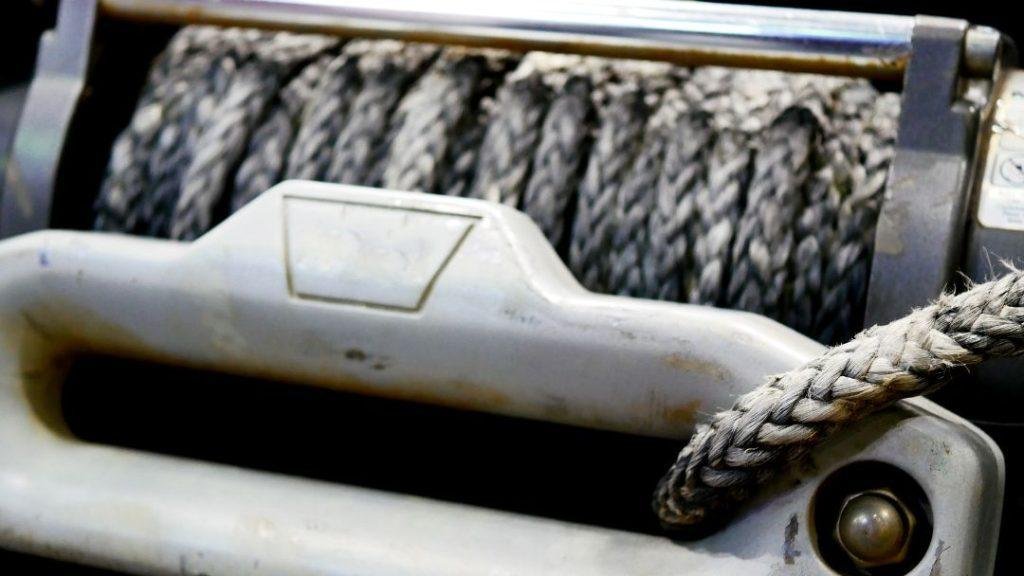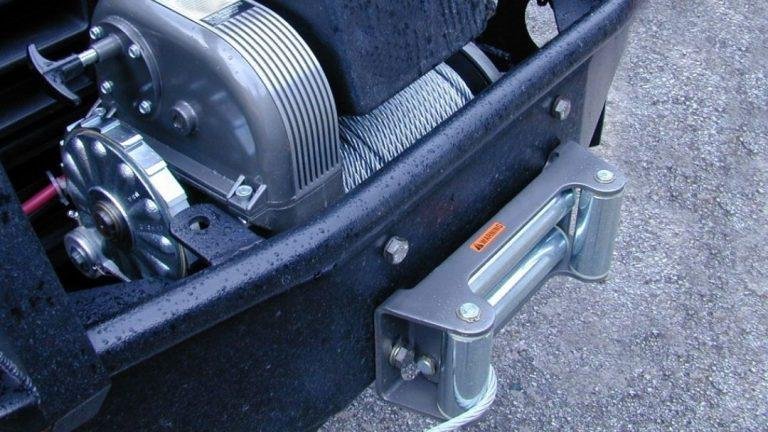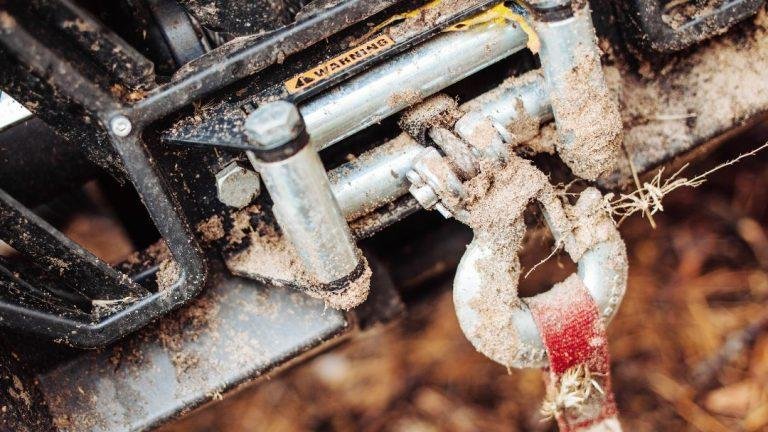For an ATV, the recommended winch rope size varies depending on the weight of the vehicle and the terrain. In order to ensure the smooth and efficient operation of an ATV winch, it is crucial to choose the correct winch rope size.
The right size will provide the necessary strength and durability for the specific vehicle and terrain, allowing the winch to properly handle the load. Considerations such as weight capacity, breaking strength, and diameter should all be taken into account when selecting the appropriate winch rope size for an ATV.
By choosing the correct size, ATV owners can maximize the performance and safety of their winching operations.
Factors To Consider When Choosing Winch Rope
Choosing the right winch rope size for your ATV is crucial for optimal performance. Consider factors such as the weight of your ATV, the terrain you’ll be traversing, and the pulling capacity of your winch to ensure you select the appropriate winch rope size.
When it comes to choosing the right winch rope for your ATV, there are a few factors that you should consider. The size of the winch rope plays a crucial role in its performance and durability. In this section, we will explore the key considerations to keep in mind when selecting the appropriate winch rope for your ATV.
Strength And Load Capacity:
- Breaking strength: The breaking strength of the winch rope is an important factor to consider. It refers to the maximum load the rope can withstand before it breaks. Make sure to choose a winch rope with a higher breaking strength than the maximum load your ATV may encounter.
- Working load limit: The working load limit indicates the maximum weight that the winch rope can handle without causing damage. It is generally recommended to select a winch rope with a working load limit greater than the weight of your ATV.
Durability And Resistance To Abrasion:
- Material: The material of the winch rope directly affects its durability and resistance to abrasion. Synthetic rope made from materials like Dyneema or synthetic fiber blends is preferred due to its high strength and resistance to wear and tear.
- Coating: A protective coating on the winch rope can enhance its durability by providing resistance to UV rays, moisture, and abrasion. Look for winch ropes with a reliable coating to ensure longevity.
Ease Of Handling And Storage:
- Flexibility: Winch ropes that are flexible and easy to handle prove to be efficient during usage. Be sure to select a rope that is easy to work with and won’t tangle or kink during operation.
- Lightweight: Consider the weight of the winch rope as it can affect the ease of carrying and storing it. Lighter ropes are more convenient to handle and store.
Compatibility With Your Winch:
- Size and diameter: Ensure that the winch rope you choose is compatible with your ATV winch drum size by matching the winch rope diameter to the recommended drum size mentioned in your winch’s specifications. Using an incorrect size may result in decreased performance or damage to the winch.
- Attachment: Check if the winch rope has a proper attachment mechanism compatible with your winch. Common attachment options include hooks, thimbles, or loops. It is essential to choose a winch rope with the appropriate connection method for easy installation and secure attachment to your winch.
By considering these factors, you can select the appropriate winch rope size for your ATV. Remember to prioritize strength, durability, ease of handling, and compatibility with your ATV winch for optimal performance.

Understanding The Different Types Of Winch Rope
Understanding the different types of winch rope for an ATV is important. Knowing what size winch rope to use can make a big difference in the effectiveness of your winching operations.
When it comes to choosing the right winch rope for your ATV, there are two primary options to consider: synthetic rope and steel cable. Each has its own pros and cons, so it’s crucial to understand the differences between them before making a decision.
Synthetic Rope
- Synthetic winch rope is made from high-strength fibers such as Dyneema or spectra. These fibers offer excellent strength-to-weight ratio and are highly resistant to abrasion and UV rays.
- It is significantly lighter than steel cable, which makes it easier to handle and transport.
- Synthetic rope is also safer to use as it doesn’t recoil like steel cable in case of failure.
- It can be easily repaired in the field in case of any damage by using a simple knot, unlike steel cable.
- Synthetic rope is more flexible than steel cable, allowing it to wrap around the winch drum more easily and preventing it from getting as tangled.
- However, synthetic rope is prone to fraying and can be more expensive compared to steel cable.
Pros And Cons Of Synthetic Rope:
- Lightweight and easy to handle and transport, making it suitable for off-road adventures.
- Highly resistant to abrasion and UV rays, ensuring long-lasting use.
- Safer to use as it doesn’t recoil like steel cable in case of a failure.
- Easy to repair in the field in case of any damage by using a simple knot.
- More flexible than steel cable, preventing tangling.
- Prone to fraying and can be more expensive than steel cable.
Choosing The Right Diameter For Your ATV:
- The diameter of synthetic winch rope usually ranges from 3/16-inch to 3/8-inch.
- For ATVs, a diameter of 1/4-inch to 5/16-inch is generally recommended.
- Consider the weight and pulling capacity of your ATV when choosing the diameter of the winch rope.
- Thicker ropes offer higher load capacity but may require larger winch drums, so ensure compatibility with your ATV’s winch.
Steel Cable
- Steel cable has been the traditional choice for winching applications due to its high durability and strength.
- It is less affected by sharp objects or extreme heat compared to synthetic rope.
- Steel cable is more resistant to fraying and can handle heavier loads without breaking.
- However, it is significantly heavier than synthetic rope, making it more cumbersome to handle and transport.
- It can recoil and snap back if it breaks, posing a potential safety hazard.
- Steel cable is also prone to rust and corrosion if not properly maintained.
Pros And Cons Of Steel Cable:
- High durability and strength, make it suitable for heavy-duty applications.
- Less affected by sharp objects or extreme heat compared to synthetic rope.
- More resistant to fraying and can handle heavier loads without breaking.
- Significantly heavier and more cumbersome to handle and transport.
- May recoil and snap back if it breaks, posing a potential safety hazard.
- Prone to rust and corrosion if not properly maintained.
Determining The Right Diameter For Your ATV:
- Steel cable comes in various diameters, typically ranging from 3/16-inch to 3/8-inch.
- For most ATV winching applications, a diameter of 3/16-inch to 1/4-inch is commonly used.
- Consider the weight and pulling capacity of your ATV when selecting the diameter of the steel cable.
- Thicker cables offer higher load capacity but may require larger winch drums, so ensure compatibility with your ATV’s winch.
With a clear understanding of the pros, cons, and suitable diameter choices for both synthetic rope and steel cable, you can make an informed decision when selecting the right winch rope for your atv. Remember to prioritize your specific needs and preferences while considering the overall performance, safety, and durability of the rope material.
Comparing Synthetic Rope And Steel Cable
Comparing synthetic winch rope and steel cable for ATVs: determine the appropriate size depending on your vehicle’s weight and power. Synthetic rope is lightweight, flexible, and easy to handle, while steel cable is stronger but heavier. Choose wisely for optimal performance.
Performance and strength:
- Synthetic rope is lighter and more flexible than steel cable, allowing for easier handling and improved performance.
- Synthetic rope exhibits significantly lower snap-back potential, reducing the risk of serious injury or property damage.
- Steel cable is known for its exceptional strength and durability, making it ideal for heavy-duty applications and extreme off-road conditions.
Weight and handling:
- Synthetic rope weighs considerably less than steel cable, reducing the overall weight of the winch system and minimizing strain on the ATV.
- The lighter weight of synthetic rope enhances ease of handling, enabling quick and efficient operation.
- Steel cable is bulkier and heavier, which can make it more challenging to handle and maneuver during winching operations.
Safety and maintenance:
- Synthetic rope is deemed safer due to its lower snap-back potential and minimal risk of fraying or splintering. It is also easier to handle without gloves, reducing the risk of hand injuries.
- Synthetic rope requires minimal maintenance as it is resistant to water, UV rays, and chemicals, resulting in a longer lifespan and decreased need for regular inspections.
- Steel cable, on the other hand, requires more frequent maintenance to prevent rust, corrosion, and kinks. Additionally, steel cables can develop sharp burrs over time, posing a safety hazard.
Cost and longevity:
- Synthetic rope generally comes at a higher initial cost compared to steel cable. However, it offers a longer lifespan and reduced maintenance requirements, resulting in potential long-term cost savings.
- Steel cable is cheaper upfront but may require more frequent replacements due to wear and tear. The maintenance costs associated with steel cables should also be considered.
When choosing a winch rope for your ATV, consider the performance and strength required, the weight and handling preferences, safety concerns, as well as cost and longevity. Synthetic rope offers improved handling, safety, and longevity but comes at a higher initial cost.
Steel cable, although heavier and requiring more maintenance, is known for its exceptional strength. Choose the option that best suits your specific needs and preferences.
Selecting The Proper Winch Rope Size For Your Atv
Choosing the right winch rope size for your ATV is crucial for optimal performance. Find the perfect size to ensure your winch can handle the load and provide the necessary pulling power without compromising safety.
Identifying Your Atv’S Weight And Load Capacity
- Determine the weight of your ATV and its load capacity before selecting the appropriate winch rope size.
- Consider the weight of additional accessories or equipment you may be using while winching.
- Bullet point: Heavy ATVs with higher load capacities require thicker and stronger winch ropes, while lighter ATVs can typically utilize thinner ropes.
Matching The Rope Diameter To Your Winch Capacity
- Check the manufacturer’s specifications or the owner’s manual of your winch to determine its capacity.
- Bullet point: Match the rope diameter to the winch capacity for optimal performance and safety.
- Bullet point: Thicker ropes offer greater strength, while thinner ropes may provide more flexibility.
- Bullet point: Ensure that the winch rope has a breaking strength that exceeds the pulling capacity of your winch.
Considering The Terrain And Off-Roading Conditions
- Assess the type of terrain you will be navigating while using your ATV and winch.
- Bullet point: Rough terrains such as rocky or muddy trails may require stronger winch ropes to withstand the strain.
- Bullet point: Softer terrains like sand or snow may necessitate thinner ropes to prevent excessive digging into the ground.
Evaluating Your Winching Style And Frequency
- Determine how frequently you plan to use your winch and your winching style.
- Bullet point: Regular winching or heavier loads may require thicker and stronger ropes for enhanced durability.
- Bullet point: Occasional winching or lighter loads may allow for the use of thinner ropes for better flexibility and weight savings.
Selecting the proper winch rope size for your ATV involves considering factors such as the ATV’s weight and load capacity, matching the rope diameter to the winch capacity, evaluating the terrain and off-roading conditions, and assessing your winching style and frequency.
By taking these factors into account, you can ensure choosing the right winch rope size that meets your specific needs and maximizes the effectiveness and safety of your ATV winching operations.
Tips For Maintaining And Extending The Lifespan Of Your Winch Rope
Looking to extend the lifespan of your ATV winch rope? Here’s some invaluable advice on choosing the right size winch rope for optimum performance and durability. Follow these tips to ensure a longer-lasting and more reliable winch rope on your ATV.
Proper cleaning and storage techniques:
- Regularly rinse off your winch rope with clean water after each use to remove dirt, mud, and debris that can cause abrasion or damage.
- Use a mild soap or detergent and a soft brush to gently scrub away any stubborn stains or contaminants.
- Avoid using harsh chemicals or solvents as they can weaken the fibers of the rope.
- After cleaning, make sure to thoroughly dry the winch rope before storing it to prevent mold or mildew growth.
- Store the winch rope in a cool, dry place, away from direct sunlight or extreme temperatures.
Inspecting for signs of wear and tear:
- Periodically inspect your winch rope for any signs of fraying, cuts, or abrasion. These can weaken the rope and decrease its load capacity.
- Check for any knots or tangles that may have formed during use and untangle them carefully.
- Look for any broken or damaged strands of the rope and address them promptly to prevent further deterioration.
- Pay attention to the spliced or end sections of the rope, which are more susceptible to wear and tear.
- If you notice any significant damage or wear, consider replacing the winch rope to ensure safe and reliable operation.
Regular lubrication and protection against UV exposure:
- Apply a suitable lubricant to the winch rope regularly to keep it supple and prevent excessive friction during operation.
- Use a lubricant specifically designed for synthetic winch ropes, as certain lubricants can degrade or weaken the rope’s fibers.
- Protect your winch rope from prolonged exposure to UV rays, which can cause fading, weakening, and deterioration.
- Use a winch cover or keep the winch rope coiled and stored in a protective bag when not in use.
- Consider using a UV-resistant cover or sleeve to provide additional protection against sun damage.
Remember, by following these tips for cleaning, inspecting, and protecting your winch rope, you can ensure its longevity and maintain its performance capabilities. Regular maintenance and care will help you get the most out of your ATV winching experiences while keeping you safe on every off-road adventure.
Frequently Asked Questions About Winch Ropes For Atvs
Wondering what size winch rope is suitable for your ATV? Find answers to your frequently asked questions about winch ropes for ATVs in this informative guide. Discover the right rope size to ensure a secure and efficient towing experience.
Can You Use A Larger Winch Rope Than Recommended For Your ATV?
- Using a winch rope is crucial for any ATV enthusiast, as it can aid in difficult situations and add extra functionality to your vehicle. However, it’s important to understand the specifications and recommendations when it comes to winch ropes for ATVs. Here are some frequently asked questions to clear up any doubts you may have:
- Can I use a larger winch rope than recommended for my atv?
- It is not recommended to use a larger winch rope than what is specified for your atv. The manufacturer has determined the appropriate size based on the vehicle’s weight and pulling capacity. Using a larger winch rope may put excessive strain on the atv’s winch system, leading to potential damage or failure. Always stick to the recommended rope size to ensure safe and efficient operation.
How Often Should You Replace Your Winch Rope?
- Maintaining the condition of your winch rope is crucial for safe usage. Here are some guidelines on when you should replace your winch rope:
- Regular inspection: Examine your winch rope frequently for signs of wear, such as fraying, cuts, or abrasions. If you notice any damage, it is advisable to replace the rope immediately.
- Usage frequency: If you frequently use your winch, consider replacing the rope more often, as it is subject to more wear and tear. High-use situations, such as off-road recovery or heavy-duty pulling, can accelerate rope degradation.
- Time-based replacement: Even if your winch rope appears to be in good condition, it is recommended to replace it every 3-5 years. Over time, exposure to sunlight, moisture, and other environmental factors can weaken the rope’s strength and durability.
- Following these guidelines will help ensure that your winch rope remains in optimal condition, reducing the risk of unexpected failure during critical moments.
Can You Use A Winch Rope With Different Diameters On The Same Atv?
- Using winch ropes with different diameters on the same atv is not recommended. It is crucial to use a winch rope with the recommended diameter specified by the manufacturer. Here’s why:
- Consistency: A winch system is designed to work with a specific diameter of rope. Mixing different diameters can affect the winching performance, potentially leading to system failure or decreased efficiency.
- Amperage requirements: The amperage draw of the winch motor is designed to work with a specific rope diameter. Using a different diameter can alter the load on the motor, potentially causing overheating or inadequate pulling power.
- Compatibility: Winch ropes with different diameters may not fit properly on the winch drum or have the correct connections, compromising their functionality and safety.
- Always use the recommended winch rope diameter specified by the manufacturer to maintain optimal performance and safety.
Are There Any Safety Precautions When Using Winch Ropes?
- Working with winch ropes involves potential risks, so it’s crucial to take the necessary safety precautions. Here are some key measures to keep in mind:
- Personal protective equipment (PPE): Wear appropriate PPE, including gloves and eye protection, to protect yourself from rope splinters, debris, or potential recoil.
- Proper anchoring: Always ensure that the anchor point is sturdy and suitable for the load. Use a tree trunk protector or a snatch block for added stability when anchoring to tree trunks.
- Avoid overload: Be aware of the winch’s rated capacity and avoid surpassing it. Overloading the winch can damage the rope, winch system, or other components, posing a safety hazard.
- Use of dampeners: When winching, use a dampener or a blanket to absorb potential energy when the rope is under tension. This will minimize the risk of recoil and protect against accidental snapping.
- Correct technique: Understand and follow proper winching techniques, such as maintaining a straight line pull and avoiding sudden jerks or rapid releases of tension.
- Stay clear and alert: Keep bystanders at a safe distance during winching operations. Maintain constant vigilance and stay clear of the rope path to avoid potential accidents or injury.
- Always prioritize safety when using winch ropes for your ATV. By following these precautions, you can enjoy your off-road adventures with peace of mind.
Remember, understanding winch ropes for your ATV is essential for safe and effective usage. These frequently asked questions provide a comprehensive overview to guide you toward making informed decisions. Stay informed, stay safe, and enjoy your ATV adventures to the fullest!
Frequently Asked Questions
What Size Is Atv Winch Cable?
Atv winch cables typically come in a variety of sizes, ranging from 3/16 inch to 7/16 inch. The size you choose depends on the specific ATV winch and its load capacity. It is important to check the manufacturer’s specifications for the recommended cable size for your winch.
What Winch Cable Is Best For Atv?
For the best ATV winch cable, opt for synthetic rope over steel cable. Synthetic rope is stronger, lighter, and safer. It is easier to handle and doesn’t have the same recoil dangers as steel cable. Look for a synthetic rope with a high breaking strength and a protective coating, which enhances durability and longevity.
Also, consider the diameter of the rope. Thicker ropes offer more strength but may require a larger winch drum. Finally, make sure the rope is compatible with your atv winch’s weight rating. Consult your atv’s manual to determine the maximum recommended pulling capacity.
Overall, synthetic rope is the preferred choice for ATV winches due to its superior performance and safety features.
How Long Should Your Winch Rope Be?
A winch rope should be long enough to reach the anchor point and still have some extra length for safety. The length of the rope will depend on the specific requirements of the winching task. Generally, a winch rope should be at least 1-1.
5 times the distance between the winch and the anchor point. This allows for enough rope to handle various scenarios and ensures that the rope doesn’t run out of length before the task is completed. It’s better to have a longer rope than a shorter one, as you can always secure the excess length.
However, make sure the rope doesn’t become too long and gets tangled or damaged during operation. Always refer to the manufacturer’s guidelines for the recommended rope length for your specific winch model.
How Strong Is 3 16 Winch Rope?
A 3/16 winch rope is designed to handle heavy loads and provide strong pulling power. It is made from high-strength synthetic fibers, such as Dyneema or spectra, which give it exceptional strength and durability. With a breaking strength that can range from around 5,000 to 7,000 pounds, this winch rope is capable of withstanding significant force.
Its strong construction ensures that it can handle the toughest tasks, whether it be pulling a vehicle out of a ditch or hauling heavy equipment. The 3/16 winch rope is a reliable and robust option for any winching application. It offers peace of mind, knowing that it can handle the job efficiently and effectively.
Conclusion
After carefully considering the various factors involved in choosing the right size winch rope for your atv, it is clear that finding the perfect balance between strength and functionality is key. Opting for a winch rope with a diameter that matches the weight and power of your atv is crucial for efficient and safe operations.
Additionally, considering the type of winch rope material, such as synthetic or steel, can also impact its performance in different situations. It’s important to assess your specific needs, and potentially consult with professionals or fellow atv enthusiasts, to ensure you select the appropriate winch rope size for your atv.
Remember, investing in quality equipment that matches the requirements of your atv will not only enhance your off-road adventures but also provide peace of mind knowing you are well-prepared for any challenging terrain. So, take the time to research, evaluate your options, and make an informed decision to enhance your atv experience.




